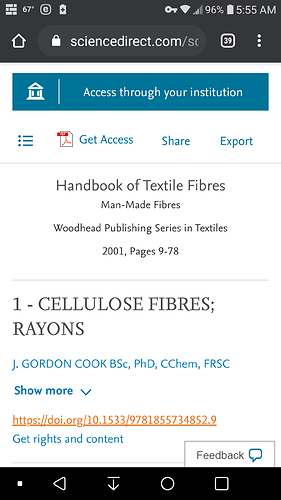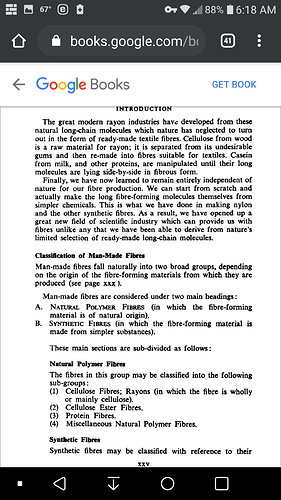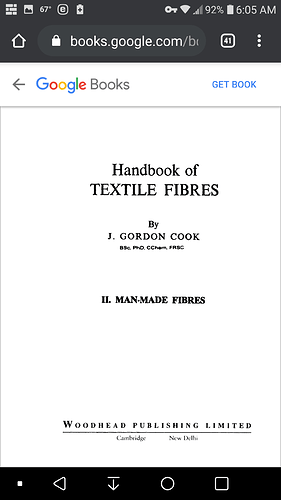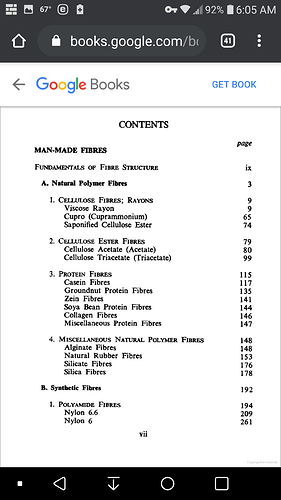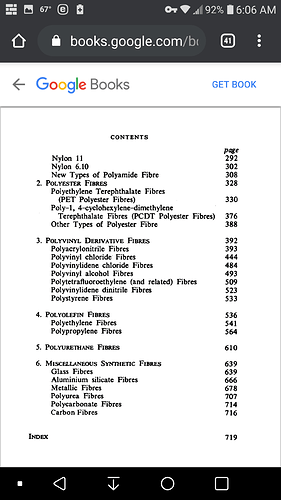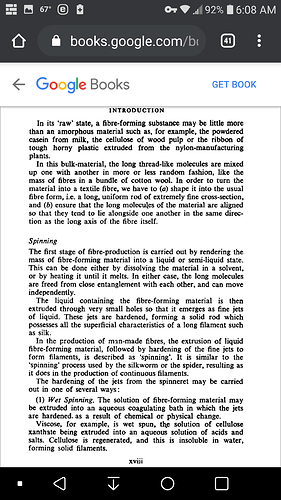Soo many in my life, I’m a mesh wick only, but without those DH you’ll never learn when the alarm bell starts ringing, but if you don’t take care or forgot about that alarm, you’re in for some serious troubles… you learn…
I first got rayon because I had an rta that was very very difficult to wick, primary problem was dry hits. Rayon widened the sweet spot between dry hits and leaks, making it much easier to wick in one try. I switched all my rta’s immediately, and when I ran out of cotton bacon for my rda’s I just never bought anymore because I have 500ft of rayon and it only cost me $15, which at the time was 3 packs of cotton bacon V2 at any local shop.
One section of the rayon long enough to wick a coil is thick enough to do two 3mm coils, so that means a couple inches of that 500ft is all that’s needed to wick one dual coil or two single coil atty’s, I will basically never run out lol.
I’ve never used rayon. Primarily because my concern has always centered around the historical knowledge that (at least in my generation) it was a synthetic polymer (read as: plastics based).
I’ve read on a couple of accounts here, where it has been proposed that that’s “no longer necessarily the case” (paraphrasing).
Not having researched it much outside of these walls, I am still “hung up” on the idea that “that’s hard to swallow”. It just seems contrary to the original creation. (For example: I’d have the same reaction if someone suggested that polyester was now available using all natural fibers.)
I’m not saying folks (in the other rayon threads) are lying about what they may have read, I’m simply saying I’m sceptical.
I’ve been watching the whole thing (continued rayon discussions) with interest solely because I like the idea of not having the chemical components of flavors accumulate in the wick. As well as a secondary interest in the reportedly faster wicking… But until I can achieve a certain level of comfort about the safety of it, then I’ll continue to “read with interest”. ![]()
Thanks for that. It does look interesting, I have to admit. I may well give it a try when I next order. Still got a ton of Muji. As I said I almost never suffer dry hits but it would be nice not to have to re-wick every time I change flavour. Especially with SFT. Always thought that rayon was basically plastic though. Decisions, decisions.
I have to admit that I was under the same impression. Always thought it was “plastic.” I’m in two minds about it now.
I’m kind of in the same camp as @Sprkslfly, I’ve had countless people tell me how opposite (but good) Rayon is/was from cotton. Even picked up a box, and just neeeeeever got around to it. Not sure why. I mean, when I think about it, cotton’s natural, but a lot of my flavors aren’t LOL, so, not sure exactly what my hold up is. I TOO, will keep watching this thread…
Rayon is 100% cellulose, it’s the plant matter that makes trees and even cotton
If you refined cotton you could make rayon.
It’s often made from wood pulp it’s not synthetic or a polymer either cotton vapers are already vaping smaller amounts of rayon and we also eat this stuff daily
Cotton is a mixture of organic compounds including cellulose (rayon) and proteins so I’m pretty skeptical cotton would cause less issues than rayon, as torturedZen pointed it wouldn’t surprise if it was rayon dust or little fibres going free, rayon does that much more than cotton
I have been using rayon for over a year and will never go back to cotton
-
I switch between 8 or so different flavours every few ML’s and rayon doesen’t hold onto flavours a few vapes and you only get the new flavour
-
The wick lasts at least twice as long as cotton and dosen’t carameliZe or gunk up like cotton never seen a wick go darker than the juice vaping
-
it wicks FAST and I prefer the flavour I get from it
But wicking with rayon is harder to get right you have to spend more time making your wick, I can give tips if anyone is interested though
I have been using rayon for more than 2 years now, and no way I’d go back. Tried cotton recently and it was yuck 
The biggest difference for me was flavour, cotton changed the flavour for me in the same manner any other coil than SS does.
And have to agree with the points @warkwarth makes above
There are also different types as well as processing methods…and with this being a fringe industry, I’m not confident in the sellers, for our intended purpose (never mind the issues surrounding the product). Because the majority aren’t going to divulge their source (point of origin) of the rayon, much less be aware of the process their manufacturer uses.
If that’s the case, then how can they (the link above) go on to say:
200°C = 392°F
Which is well within the usage of many TC vapers (and definitely in range of most high power vapers).
Now, I’ll say write clearly, I’m NOT a chemist, nor even remotely qualified as such. But I’m not going to take “vape marketing” speak for matters of science (in cases such as this). The same way I don’t buy into the bs about D/A/AP, because if diacetyl was a threat at the levels we use them at, and cigarettes have 100’s to 1000’s of times the amount of diacetyl, then IF there was a threat, shouldn’t we have a long scientifically proven history of millions of smokers with popcorn lung?? ![]()
But I digress.
Now the following only applies to the upper end (a low percentage of vapers), but is still worth mentioning (to the topic at large, because it could also explain some of the nastiness of the dry hit):
310°C = 590°F
Still within the range of many vaping devices.
I will definitely say thank you @warkwarth for replying, because even though I (currently) stand in uncertainty, your thoughtful response caused me to continue to look further into the science of it.
While I still don’t have a full understanding, I have a better understanding.
Other points (from my link above) I found interesting, and worth sharing:
Also worth noting IMO, that there is ZERO mention of Rayon in the link.
Looks like I’ll need to research further about the science involved with the relationship between the two…
thanks to you as well im no chemist either and I actually like when people debate
I don’t take it personally or anything it’s for the greater good really.
Upon further reading it looks like rayon (cellulose) IS considered a polymer and so is cotton but that dosen’t mean plastics, wikipedia says it’s a substance or material consisting of very large molecules, or macromolecules, composed of many repeating subunits.[
From what I have read depolymeriZation is a common process and it looks like cotton goes through the same process but with different starting ingredients, cotton has a high % of cellulose plus other things
In the link you gave about cellulose it even states cotton is 50 - 95% cellulose at the top left (at least the cotton they used in the test) but the caveat is there many grades of rayon and cotton with different refining methods
Rayon is just cotton with fewer ingredients and the heat propertys have been tested and documented by multiple vapers, if depolymeriZation is an issue with rayon I think it’s even worse with cotton but that is just my opinion from using it
less gunking and the wicks last 2 - 4 times longer to seems like it is breaking down slower than cotton does
I like a good discussion of a fresh topic

Thank you so much for holding this outlook!
I share it FWIW. ![]()
This single line nicely sums up what has remained as the central point of contention for me over the last few years of reading vapers thoughts.
For my position (point of view), it’s the exact opposite. Cotton is the (only 100%) natural material (for our purposes) in the vaping discussion.
Now, I also want to make clear that I don’t believe that all cotton on the vape market is pure (or has had zero processing). Quite the opposite I’m sure.
But in keeping focused with the base material (cotton vs rayon), I’m having difficulty (thus far) finding the composition of rayon (with any scientific [read as non-marketing, and non-wiki type stuff] that “just anybody” can add their non-accredited two cents in.)
One of the things I did stumble across (which is the history I am aware of, and why I currently have the reservations I have) was a history of Rayon, according to Mitsubishi Rayon Co Ltd. , Japan:
I’ve heard of, seen, touched, and stood in fields full of raw cotton. But (to date) I’ve never once heard of, nor read about a field of rayon (for cultivation) or “rayon seeds” for planting.
While I’m open to the idea of such existing (I’m well aware I don’t know even a smidgen of “everything” lol), I have yet to learn about it.
I personally think that a LOT of the references to rayon being “the same as cotton” (structurally speaking; because of the shared trait of containing cellulose) are in error.
Things frequently have similar base compounds (look at all the things that contain oxygen for example), but that does not mean they’re the same. ![]()
Another interesting tidbit: Study on the pyrolysis of wood-derived rayon fiber by thermogravimetry–mass spectrometry:
300-350°C = 572-662°F
Which does two things:
- really makes me glad that I tend to vape around 30-40w or so (322-400 in TC judging from the real time readings the Topsides give if they’re remotely accurate)
- makes me really want to find the equivalent information for cotton!!
Again, I appreciate the input and discussion.
If anyone has access to this, please share any relevant information to the discussion here!
I tried clicking on the doi link, but it looped back to the page I took the screenshot of (above).
https://www.sciencedirect.com/science/article/pii/B9781855734852500068?via%3Dihub
And the link in the above page:
https://doi.org/10.1533/9781855734852.9
After a little further digging… I found a preview of the book, that gives enough concrete information IMO to sufficiently answer questions I’ve had about the whole “is rayon real (natural), or synthetic (man-made)?” question that’s been eating at me few I first read about it the use of it for wicking here years ago.
The link (for those who want to read further) is: Handbook of Textile Fibres: Man-Made Fibres - J Gordon Cook - Google Boeken
The key passage for me is in the following:
Soooo!
I’ve learned that I wasn’t clear in my use of the term (as it applies here) synthetic (when I said synthetic polymer, earlier in the initial conversation). What I intended was to say by using synthetic was to say man-made.
To me (a layman) synthetic has always equated to “not natural” or man-made.
Although it is glaringly obvious (to me) that there was a need to distinguish source materials for the folks in the industry, or they wouldn’t have created such classifications. (Derp. lol)
What it also reveals (in my opinion) is how some marketing entities have seemingly once again taken the facts, and hand-picked key bullet points (keywords), and “redefined” the truth.
Yes, there’s cellulose.
Yes it contains “natural fibre” origins
But it’s still a FUCKING MAN-MADE PRODUCT. /frustration is at the lies. Not anyone in the thread (irony) here!
Other shots I snapped, but am too frustrated to explain further why I took them at the moment…
All material is copyrighted (I’m sure) and is only referenced for the purposes of this discussion.
All credits due are to the author: J. Gordon Cook.
Don’t get hung up on the word “polymer”. We usually associate polymer with plastics, but carbohydrates, lipids, proteins, and nucleic acids are polymers.
Depolymerization is the process or act of breaking down a polymer into its monomeric components. An example of a biological depolymerization is the digestion of food.
Does that mean you will try rayon?
Yea it is man made but it’s a natural plant fibre
How I look at i guess is that cotton goes through processing like scouring and degumming which takes waxes and impurities out of the cotton
Making rayon takes everything else out like proteins so only the cellulose remains
I don’t know about all the technical gobbledegook that had transpired here. All I do know is that I have used rayon (a box from Sally’s Beauty Supply, $11.00) for five years. Still have a f-ton of it left. I have used it in rdtas, rtas and rdas. Why, is when I first started making my own coils, I couldn’t stand the taste of breaking in the cotton. Why I still use it is because it’s what I know and it works for me. The only dry hit I ever get is when I’m chain vaping and forget to squonk. Although, I still haven’t figured out the Profile rda or rta yet. Use what works for you. No one else’s opinion matters.
Ahh, did not know that!
Thank you for chiming in after the years lurking (glad you still do). ![]()
Appreciate your input!
After confirming that it’s totally ‘synthetic’ (man-made) chuckles, no.
I recall the dry hits from silica all too well, and if they are worse than that, I want no part of it. lol
It may have started off as a natural plant fibre, but the instant they turned it into a liquid…
In either of the cases above, IMO, there’s no longer anything natural about it. It’s been manipulated beyond the point of being able to think of it as natural.
I can understand that.
I could be wrong, but to the best of my knowledge, the cotton for what we use, has only been “washed” (in my mind’s eye). Yes, it could be bleached, or whatever else they do to clean it. But, as far as I know, it’s never reached a state of “decomposition” (like what rayon has), and then “rematerialized” through artificial means.
It’s strange, I realize, but this is one of those personal things. It’s really small in relation to the big picture. And damned near anything in vaping is far and away better than the damage being done by smoking (barring using flavors that contain oils, etc).
But in the few things that we actually have control over (well, those of us who build and wick our own lol), I just feel more at ease “accidentally breathing in slightly singed cotton”, than I do “accidentally breathing in slightly singed artificial material”. ![]()
totally understand I feel the same way about inhaling singed cotton vs rayon since our wicks should always be wet It shouldn’t really happen
The fact that it changes states to a liquid before it is made into rayon dosen’t bother me so much, we can change nicotine to a powder or liquid or gas and it’s still nicotine
For me i’m more worried about the by-products from vaping camareliZed gunk (acrolein, formaldehyde etc)
Some flavours like watermelon would stick around for a full 5ML tank or longer with cotton but that never happens with rayon
The way I can switch between 8 different flavours and have no previous flavour within a few vapes hints that juice isn’t getting stuck in the wick and cooking or camareliZing
The wicks always look cleaner and much less dark
My anecdotal opinion anyways
And yes a thousands if not millions of times less harmful than cigarettes
just look at how much radiation we are not getting anymore
